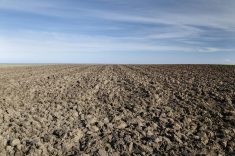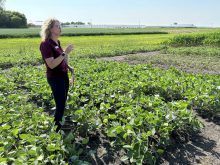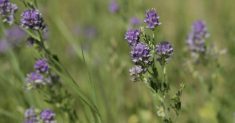SOUTHWEST REGION
Seeding has just begun only on fields that can be travelled on. Hard red spring wheat and canola have been the crops most producers are concentrating on. Rainfall of 15-35 mm at the beginning of the week delayed seeding and field work to the weekend. Warm weather and wind over the weekend helped dry fields. Warmer weather has helped many weeds to emerge; pre-seed burn-off herbicides will be critical for decreasing weed competition.
Winter wheat and fall rye that is not under water looks good. Producers plan on fertilizing and controlling weeds shortly. Pastures are greening up with the warm weather and producers may be able to put cattle out soon. Several pastures remain under water. The biggest concerns for this area are the large amount of acres still under water and when producers will get these acres seeded.
Read Also

Manitoba canola industry has new frontiers
Canola oil is still the main priority for the sector, but canola meal is increasingly the subject of research looking for new markets and uses for the oilseed’s byproduct.
NORTHWEST REGION
Seeding start dates continue to be delayed. Cooler temperatures with no additional precipitation during the week allowed field conditions to improve. In the Duck Mountains to Lake Manitoba region and in The Pas, with wet soils, ponding and localized flooding continue to be an issue. Through Roblin and most of the Swan River area, seeding and fertilization on lighter and better drained soils is underway. Early stages of weed growth and germination of volunteer crop are evident on drier soil. Pastures and forages are developing slowly with the cool temperatures. Flooded pastures and ponding on forages are draining slowly, but are beginning to dry up. Water levels on Lakes Winnipegosis and Dauphin continued to increase this past week. Some livestock operations relying on low-lying adjacent land are affected with increased flooding, delaying pasture development and availability of grazing and forage.
CENTRAL REGION
Seeding progress is around five per cent for most areas, except in the Carberry area where 20-30 per cent of potatoes are planted. Wet and cold weather conditions prevailed during the week, preventing planting progress. Light but steady rainfall and melting snow events brought five to 20 mm. Given the current moisture conditions, it is expected to take seven to 10 days before seeding conditions are ideal.
Some seeding this weekend occurred in areas that allowed field access. The most progress was in the Carberry area on the lighter soils. Drier fields have developed good weed growth and pre-seed burn-offs are expected to be widely used as field conditions allow access.
Fertilizer was applied to winter cereals and perennial ryegrass where access was possible. Winter cereals survived the winter fairly well and regrowth is noticeable. Pasture and hayfields are slow growing, but will increase growth with warmer temperatures.
Producers running low on feed are starting to move animals to pasture. Flood waters are still a concern in low areas close to a number of rivers and producers are unsure when field work will begin in those areas.
EASTERN REGION
Seeding is expected to resume early next week as the forecast calls for a full week of sunshine and higher temperatures. There is no mention of any cropping changes yet. No significant precipitation during the week, although rainfall amounts did vary with isolated heavier accumulations in some areas.
Overnight temperatures in some areas were below freezing at night and daytime highs below normal. The weekend brought warm, sunny conditions, with strong winds, creating excellent soil drying conditions towards the end of the week. Wet soils and standing water are still visible in low-lying areas in some fields, but are improving quickly. Producers were cultivating and harrowing in St. Malo, Ste. Anne and St. Pierre areas in order to dry the seedbed enough to seed by May 16. Wheat, canola and corn are expected to resume seeding operations while soybeans are expected to be sown mid next week. Weeds are becoming apparent with vigorous populations of wild oat, stink-weed and thistles in many areas. Many have started applying pre-seed weed control herbicides.
INTERLAKE REGION
Some seeding has begun in the south Interlake but most areas will need a week or more of drying to allow for good soil conditions. Clouds with scattered precipitation throughout the week brought five to 10 mm of rain across the region.
Strong drying conditions over the weekend have improved field conditions and seeding operations will begin soon. Forage growth on hay and pasture have improved with warm temperatures and more than adequate soil moisture. Fertilizing on perennial forages is ongoing where field traffic is possible. High water levels on small lakes around the Interlake are leaving many producers without the use of summer pastures.
Feeding of cattle is difficult in these areas as access lanes and feeding areas are under water and/or rutted from livestock and feeding equipment. Cattle are being relocated to higher ground from low areas across the region. Emergency pastures and alternate feeding areas are being utilized and producers with extra pasture or high ground are asked to call your local MAFRI office so that your location can be listed.


















